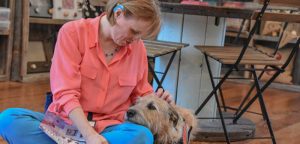By Kim Hilsenbeck
Anne Kay is no longer able to get around on her own. She uses a motorized chair most of the time, though she can still take a few steps every now and again. But her primary lateral sclerosis, a very rare disease, has progressed over the last ten years to the point where her wheelchair is her primary mode of movement.
Back in December, Kay brought home Oz, an 80-lb black lab mix, to assist her with tasks around her Wimberley home. Oz spent about a year in training to become a service dog, preparing to work with persons with disabilities.
“He is a wonderful dog,” Kay said during an interview at the training facility. “He’s like an 80-lb toddler.”
Oz received his training from Service Dogs, Inc. in Dripping Springs. This nonprofit trains about 15 dogs a year to be service dogs.
Kay went through an intensive weeklong training at the facility, then every week for two hours at home for about 13 weeks, which can be extended if circumstances warrant it.
Founder Sheri Soltes said it costs about $20,000 per dog, but recipients are only charged a $25 application fee.
“Somebody with a disability has enough challenges,” she said. “Once they get the dog, they are responsible for the dog’s upkeep which includes food, medicine and vet care.”
Soltes said community support along with an annual fundraiser, the Mighty Texas Dog Walk, helps cover the training costs as well as running the facility. The 2014 event brought in more than $80,000 in net profit.
“Our goal these days is 15 placements a year,” she said.
Matching the right dog with the right person is a goal of the organization.
Kay said during the orientation with Service Dogs, Inc., that she really liked Oz.
“So I was absolutely thrilled when it turned out he was available,” she said.
Oz helps Kay open doors, get items out of the fridge and other small tasks. He also provides companionship and some level of protection.
As part of the training process, Oz must be seated by Kay before someone tries to touch, pet or allow him to sniff a hand.
Is Oz affectionate?
“Yes, but it’s a bonding process,” Kay said.
Another process was getting oriented to her house.
“Deer distraction was problem at first,” she said.
She spent time working with Oz on not being distracted by the deer outside.
“Otherwise, he’s done extremely well at getting used to my home and his space/place,” she said.
While there is no sign yet of her disease spreading to her upper body, Kay said, “Oz will become more important to me if that happens.”
Kay’s condition is so rare that only about 500 to 2,000 people in the United States have been diagnosed with the disease. Many neurologists believe it’s a mild form of ALS, which means it’s not life threatening. But it took six years for doctors to make the diagnosis for Kay.
Working from home part-time, Kay said she and Oz have developed a routine.
“In the mornings when I first brought him home, he would get real antsy and whine and bark; now he understands when I’m getting ready,” she said. “We have a pattern.”
The next challenge, she said, will be to travel with Oz. She said he’s done well at the small outings they took together, such as to the Wimberley Library, but she loves to go on trips.
How does Service Dogs, Inc. match a canine to a person?
Soltes said part of it is through the application process where potential recipients mark down their needs and preferences.
“We’re looking for whoever can have the best chance of being successful,” she said.
The organization takes preferences into account, but a big consideration is, what behaviors does a recipient need? How good is the dog at executing those behaviors?
“If somebody is in a wheelchair, what’s the size of the chair and is that a good match with a particular dog?” she said. “We want objects retrieved [by the dogs] to be brought to the person’s lap. A small dog with someone in a very tall chair probably wouldn’t work.”
She said her training staff also consider whether a dog wants lots of attention.
“We may have a dog that is happy to be [in the home] but doesn’t want to snuggle all the time,” she said.
In the end, it’s really trying to match personalities and specialties.
“At about six months [into training], we invite people on the list to meet one or more dogs and try to match dogs to people.”
Kay looked into other service dog centers, but said she really liked Service Dogs, Inc. because they use all rescue dogs. Oz came from PAWS in Kyle.
Soltes founded the service dog training organization in 1988. She was a trial lawyer in Houston for many years, but found the work less fulfilling than she had hoped.
“I looked for other opportunities,” she said. “Then I read an article about service dogs.”
She started the nonprofit on the side, but within three years was doing that work full-time and left her legal career. Now, 26 years later, 10 of those in Dripping Springs, she is pleased at how things worked out.
“This has been a really good fit for us,” Soltes said.
Moving everything from Houston to Central Texas was done in part to centralize all of the training. She said her trainers used to work with the dogs from their homes.
She has nine trainers on staff right now. Recently, she started a trainer’s academy, where people come from around the country and Europe to learn from her staff.
“Our success rate is higher than those [training centers] who use purebred dogs,” Soltes said.
With that expansion, Service Dogs, Inc. is becoming a knowledge and industry leader.
“We can rescue more dogs and help more people by training more people to do it,” she said.








